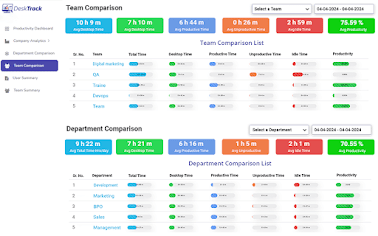Nowadays, everything is data-driven, employee monitoring included. These days you need values to identify how your employees are performing. How efficient and productive they are and what improvements you need to make. For that purpose, screen capture employee monitoring is your answer. However, what’s the most effective way to do it? The answer lies in the screen capture employee monitoring feature of the employee monitoring software. But before we can understand that, we need to also wrap our heads around employee monitoring software. So, in today’s post, we will cover it all.
What is Employee Monitoring Software?
In short, employee monitoring software or software solutions for monitoring employees monitor the desktop activities of your employees. That too in real-time. This is similar to you standing behind and guiding the workflow. However, with employee monitoring software, it’s accurate and error-free. Furthermore, software for employee monitoring provides you with a plethora of features including time-tracking that improve the focus, efficiency, and productivity of your employees.
Features of Employee Monitoring Software
With that, we are done and dusted with what employee monitoring software solutions are. Furthermore, we also mentioned that they are feature-rich. However, what are these features? What do they do? How do they work? Let’s get right into it.
Real-Time Activity Monitoring
It wouldn’t be called employee monitoring software if it didn’t monitor the activities of your employees. Would it? This feature is the name of the game. How it works is that the software will keep a tab on your employees’ desktop activities based on your performance metrics. Plus, it will give you detailed reports with data such as the work hours, URLs, files, and apps used.
Work-Hours Monitoring
Whether through integration with time-tracking software or built-in, this is a very useful feature that accurately generates the total hours worked. What you get are automated or manual timesheets and task timers that help improve the focus and efficiency of your employees as they concentrate more on the task at hand than the clock ticking.
Project Management
Regardless of how complex they are, managing projects with employee monitoring software is a breeze. With most employee monitoring software solutions, you get the feature to make as many tasks, subtasks, and checklists, which makes tracking project status and other data simple and effective. Plus, working this way makes us more efficient and productive.
Remote Work Management
We love that employee monitoring software solutions also work as remote. With features including call tracking, location monitoring, communication and collaboration tools, and app usage tracking, remote work management and monitoring is also simple and effective.
Screenshot Monitoring
This is the feature of software for employee monitoring you need if you wish to streamline workflows without obstructing your employees' focus. Plus, it also makes resource redistribution obstruction-free. Besides screenshot monitoring, you also get the screen capture feature, which lets you record employee screens. Overall, it’s the best way to identify work activity patterns.
How Does Screenshot Monitoring Improve Workplace Performance?
Screenshot monitoring or screen capture monitoring gives you data-backed proof of the working patterns of your employees. However, how does that improve workplace performance? Let’s get right into it.
Streamlines Workflows
As we mentioned above, screenshot or screen capture monitoring price improves and streamlines workflows. With timely and real-time screen capture, you will be able to make the best data-driven decisions without obstructing your employees.
Increases Efficiency
When you identify work patterns in real-time, you know where there is room for improvement. Plus, making growth-driving decisions on-the-spot also becomes simple and effective.
Whether through integration with time-tracking software or built-in, this is a very useful feature that accurately generates the total hours worked. What you get are automated or manual timesheets and task timers that help improve the focus and efficiency of your employees as they concentrate more on the task at hand than the clock ticking.
Better Resource Management
This feature improves resource management as well. When you identify work patterns and room for improvement, you will know exactly where to distribute the resources. This saves you valuable time and expenses.
Better Data Security
Regular screenshot monitoring and capturing also improves data security as it can spot unusual employee behavior, and also spot and prevent insider threats and data leaks.
Conclusion
With that, we wrap up our post for today titled, How Screen Capture Employee Monitoring Improves Workplace Performance. To summarize, remote employee time-tracking software solutions with screenshot monitoring features are the need of the hour in today’s modern working environment for organizations wishing to improve workplace efficiency, productivity, and performance. With its plethora of features including real-time activity and time-tracking, screenshot monitoring, and project management, you get many advantages including improved efficiency through streamlined workflows as there is better resource management and data security. Looking for the best screen capture employee monitoring software? We recommend DeskTrack.

.jfif)







